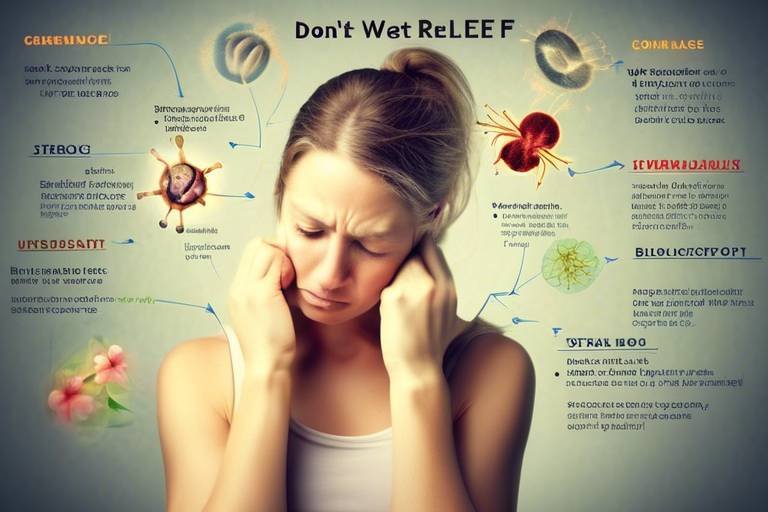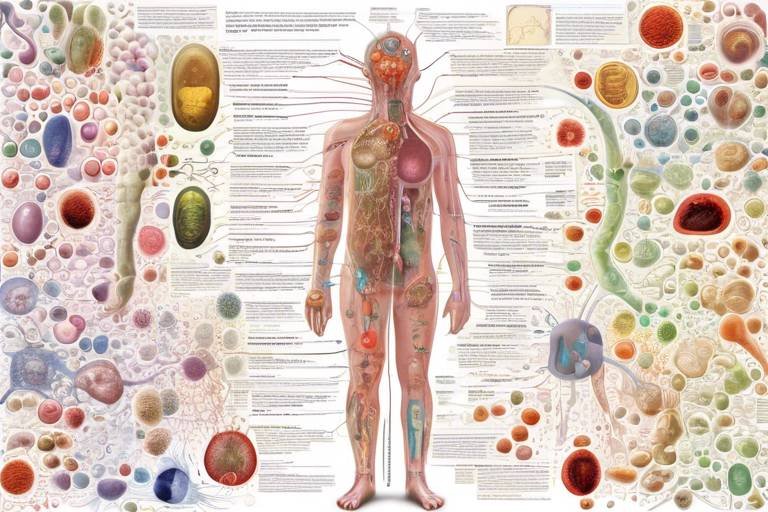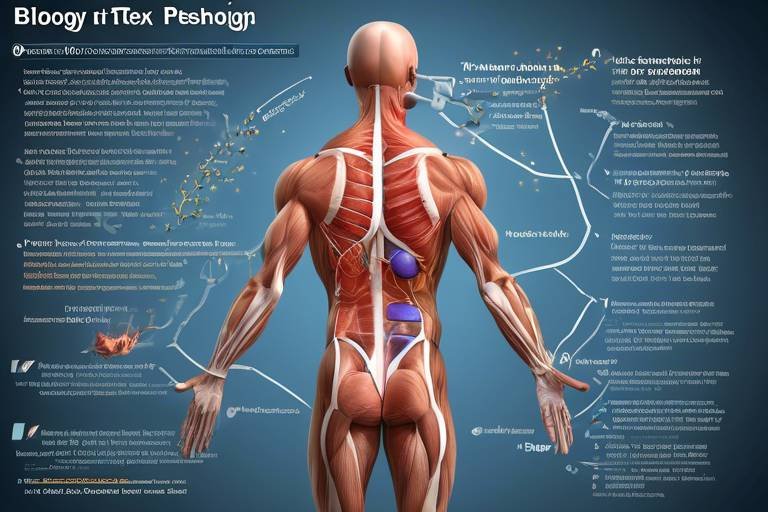The Biology of Stress Relief Techniques - What Works
Stress is an inevitable part of life, but understanding how to manage it effectively can make a world of difference. This article explores various stress relief techniques, delving into the biological mechanisms behind their effectiveness and how they can improve mental and physical health. By the end, you'll not only know what works but also why it works, allowing you to tailor your stress management strategies to fit your unique needs.
So, what exactly is stress? Biologically speaking, stress is the body's response to any demand or challenge. It triggers a cascade of physiological changes that prepare us to face threats, whether real or perceived. These challenges can stem from a variety of sources, such as work pressures, relationship issues, or even the daily grind of life. When stress becomes chronic, it can wreak havoc on both the body and mind, leading to a range of health problems, including anxiety, depression, and cardiovascular issues. Understanding the nature of stress is the first step in learning how to manage it effectively.
The autonomic nervous system plays a crucial role in regulating our stress responses. It consists of two main branches: the sympathetic and parasympathetic systems. The sympathetic system is responsible for the "fight-or-flight" response, activating our body to deal with perceived threats. On the other hand, the parasympathetic system promotes relaxation and recovery, serving as a counterbalance to the stress response. This interplay between the two systems is vital for maintaining our overall health and well-being.
The sympathetic and parasympathetic systems have contrasting roles in stress management. When the sympathetic system is activated, it releases hormones like adrenaline and cortisol, preparing the body for immediate action. This can be beneficial in short bursts but detrimental if activated continuously. In contrast, the parasympathetic system encourages a state of calm, promoting recovery and healing. By understanding these systems, we can better appreciate the importance of stress relief techniques.
When faced with a stressful situation, the sympathetic system kicks into high gear. This activation results in physiological changes such as increased heart rate, rapid breathing, and heightened blood pressure. These changes prepare the body to respond to danger but can become problematic if they persist. Chronic activation can lead to health issues like hypertension and anxiety disorders, highlighting the need for effective stress relief techniques.
On the flip side, activating the parasympathetic system has numerous benefits. It helps lower heart rate, reduce blood pressure, and promote digestion. This state of relaxation not only aids in recovery from stress but also enhances overall well-being. Techniques that stimulate the parasympathetic system, such as deep breathing, meditation, and yoga, can be incredibly effective in managing stress and improving health.
Neurotransmitters and hormones play a significant role in how our bodies respond to stress. Cortisol, often referred to as the "stress hormone," is released during stressful situations and helps regulate metabolism, immune response, and blood pressure. Adrenaline, another key player, prepares the body for quick action. Understanding these biological responses allows us to appreciate why certain stress relief techniques are effective in countering these hormonal fluctuations.
Mindfulness practices and meditation have gained popularity as effective methods for alleviating stress. Research shows that these techniques can lead to significant changes in brain function and hormone levels. When we engage in mindfulness, we train our minds to focus on the present moment, reducing anxiety about the future or regrets about the past. This shift in focus not only calms the mind but also has profound biological effects.
During meditation, several physiological changes occur in the body. For instance, heart rate variability often increases, indicating a more balanced autonomic nervous system. Additionally, studies have shown that regular meditation practice can lead to decreased levels of cortisol, promoting a state of relaxation and calm. These changes highlight the powerful impact that mindfulness can have on our overall health.
Engaging in mindfulness practices regularly can yield long-term benefits, such as improved resilience to stress. Over time, individuals who practice mindfulness often report better emotional regulation, enhanced cognitive function, and a greater sense of well-being. It's like building a mental muscle that helps you bounce back from stressors more effectively. The biological changes that accompany mindfulness can create a lasting positive impact on both mental and physical health.
Exercise is another powerful tool for managing stress. When we engage in physical activity, our bodies release endorphins—natural mood enhancers that create feelings of happiness and euphoria. This biological process not only helps alleviate stress in the moment but also contributes to long-term mental health improvements. Whether it’s a brisk walk, a run, or a yoga session, finding an activity you enjoy can be a game-changer in your stress management toolkit.
Different forms of exercise offer unique benefits for stress relief. Here’s a quick overview:
- Aerobic Exercise: Activities like running, swimming, or cycling can significantly reduce stress levels and improve mood.
- Yoga: Combines physical postures with mindfulness, promoting relaxation and mental clarity.
- Strength Training: Builds physical strength which can enhance self-esteem and reduce stress.
Regular physical activity doesn't just benefit your body; it also has a profound impact on your brain health. Studies show that exercise can improve cognitive function, enhance memory, and even help regulate emotions. The biological processes involved in these improvements are complex but fundamentally tied to the release of neurotransmitters that promote a sense of well-being. In essence, staying active can help keep your mind sharp and your stress levels in check.
Controlled breathing techniques are another effective strategy for managing stress. These practices can significantly impact the autonomic nervous system, promoting a state of relaxation. By focusing on your breath, you can help activate the parasympathetic system, leading to a decrease in heart rate and blood pressure. This simple yet powerful technique can be incorporated into your daily routine, providing a quick and effective way to combat stress.
Diaphragmatic breathing, also known as abdominal breathing, involves taking deep breaths that engage the diaphragm rather than shallow breaths from the chest. This technique can lower stress levels by increasing oxygen flow to the brain and promoting a sense of calm. Practicing diaphragmatic breathing can be as simple as finding a quiet space, closing your eyes, and focusing on your breath for a few minutes each day.
Research indicates a strong relationship between breathing patterns and heart rate variability (HRV). When you engage in controlled breathing, you can enhance HRV, which is a marker of a healthy autonomic nervous system. Higher HRV is associated with better stress resilience and overall health. By incorporating breathing techniques into your stress management routine, you can effectively improve your body's ability to respond to stress.
1. What are the most effective stress relief techniques?
There isn't a one-size-fits-all answer, as different techniques work for different people. However, mindfulness, physical activity, and controlled breathing are widely recognized as effective methods.
2. How long does it take to see results from stress relief techniques?
Many individuals report feeling calmer and more centered after just a few sessions of mindfulness or breathing exercises. However, long-term benefits typically require consistent practice.
3. Can stress relief techniques improve physical health?
Absolutely! Regular stress management can lead to better heart health, improved immune function, and a lower risk of chronic diseases.

Understanding Stress
Stress is a natural response of the body to perceived threats or challenges, often referred to as the "fight or flight" response. Biologically, stress can be defined as a state of mental or emotional strain resulting from adverse or demanding circumstances. It's fascinating how our bodies react to stressors, isn't it? Imagine your body as a finely tuned machine, where every part plays a role in keeping you safe and functioning. When you encounter a stressor—be it a looming deadline, an argument, or even a traffic jam—your body kicks into gear, releasing a cascade of hormones that prepare you to either confront the challenge or escape from it.
There are several common causes of stress, which can range from external factors like work pressure and family responsibilities to internal factors such as self-doubt and fear of the unknown. These stressors can be acute, happening suddenly and intensely, or chronic, persisting over a longer period. Regardless of the type, stress has profound effects on both the mind and body. For instance, while a little stress can motivate you to perform better, chronic stress can lead to a host of health issues, including anxiety, depression, cardiovascular diseases, and weakened immune responses.
To truly grasp how stress impacts us, it's essential to understand its physiological effects. When you experience stress, your body releases hormones like cortisol and adrenaline. These hormones increase your heart rate, elevate blood pressure, and boost energy supplies, preparing you for action. While this response can be beneficial in short bursts, prolonged exposure to stress hormones can wreak havoc on your health. For example, chronic stress can lead to:
- Increased risk of heart disease
- Weight gain
- Digestive problems
- Sleep disturbances
- Memory impairment
Understanding stress is the first step in managing it effectively. By recognizing the signs and symptoms of stress, you can take proactive measures to mitigate its effects. This includes adopting various stress relief techniques that can help restore balance to your life. In the following sections, we will explore these techniques, diving deeper into the biological mechanisms that make them effective. So, are you ready to discover the secrets of stress relief?

The Role of the Nervous System
The nervous system plays a pivotal role in how we experience and respond to stress. To put it simply, it acts as the body's command center, processing information and coordinating responses to both internal and external stimuli. When we encounter a stressful situation—be it a looming deadline, a heated argument, or even a surprise pop quiz—our nervous system kicks into high gear. This involves a complex interplay between different components, primarily the autonomic nervous system (ANS), which is divided into two main branches: the sympathetic and parasympathetic systems.
The sympathetic nervous system is often referred to as the “fight-or-flight” system. When activated, it prepares the body to face danger or escape it. This response is crucial for survival; however, in our modern lives, we often find ourselves in a constant state of low-level stress, which can lead to chronic activation of this system. Think of it as having your foot perpetually pressed on the gas pedal—eventually, that can lead to wear and tear on your body and mind.
On the flip side, the parasympathetic nervous system is known as the “rest-and-digest” system. It helps to calm the body down after a stress response, promoting relaxation and recovery. Imagine it as the brake pedal in your car; when you need to slow down and regain control, this system takes over. It encourages functions that occur when the body is at rest, such as digestion and energy conservation, allowing us to recuperate from the stresses we face.
Understanding the balance between these two systems is vital for effective stress management. When the sympathetic system is overactive, it can lead to a range of health issues, including anxiety, insomnia, and even cardiovascular problems. Conversely, when the parasympathetic system is engaged, it can foster a sense of calm and well-being, which is essential for maintaining both mental and physical health.
To illustrate this balance further, consider the following table that summarizes the roles of the sympathetic and parasympathetic systems:
| System | Function | Effects on the Body |
|---|---|---|
| Sympathetic Nervous System | Fight-or-Flight |
|
| Parasympathetic Nervous System | Rest-and-Digest |
|
By engaging in stress relief techniques that activate the parasympathetic system—such as mindfulness, meditation, or even simple breathing exercises—we can counteract the effects of stress and promote a healthier, more balanced state of being. So, the next time you feel overwhelmed, remember that your nervous system is a powerful ally. Tapping into its calming powers can lead to significant improvements in your overall health and well-being.
- What is the autonomic nervous system? The autonomic nervous system regulates involuntary bodily functions, including heart rate, digestion, and respiratory rate.
- How does stress affect the nervous system? Chronic stress can lead to an overactive sympathetic nervous system, resulting in health issues like anxiety and cardiovascular problems.
- What techniques can help activate the parasympathetic nervous system? Techniques such as mindfulness, meditation, deep breathing, and yoga can effectively activate the parasympathetic system.

Sympathetic vs. Parasympathetic Responses
When we talk about stress management, it’s crucial to understand the roles of the sympathetic and parasympathetic nervous systems. These two branches of the autonomic nervous system work together like a perfectly tuned orchestra, each playing its part to maintain balance within our bodies. Imagine the sympathetic system as the conductor, leading the charge during moments of stress, while the parasympathetic system acts as the calming violinist, soothing us back into a state of relaxation.
The sympathetic nervous system is often referred to as the body’s “fight-or-flight” response. When faced with a stressful situation—be it a looming deadline at work or a sudden encounter with a bear in the woods—this system kicks into high gear. It releases a surge of hormones, primarily adrenaline and cortisol, which prepare the body to respond to danger. This results in several physiological changes, such as increased heart rate, heightened alertness, and a rush of energy. It’s like stepping on the gas pedal of a car, speeding up to escape danger.
On the flip side, the parasympathetic nervous system is often dubbed the “rest-and-digest” system. After the threat has passed, this system takes over, promoting a state of calm and recovery. It helps lower heart rate, enhance digestion, and foster feelings of relaxation. Think of it as the brake pedal that gently slows the car down after a high-speed chase, allowing you to breathe easy and regain your composure.
To illustrate the differences between these two systems, consider the following table:
| Feature | Sympathetic Nervous System | Parasympathetic Nervous System |
|---|---|---|
| Response Type | Fight-or-Flight | Rest-and-Digest |
| Primary Hormones | Adrenaline, Cortisol | Acetylcholine |
| Heart Rate | Increases | Decreases |
| Digestion | Slows Down | Stimulates |
| Energy Levels | Increases | Restores |
Understanding these responses is essential for effective stress management. When we find ourselves in a stressful situation, recognizing whether we are in a sympathetic state or a parasympathetic one can help us take appropriate action. For instance, if we notice our heart racing and our palms sweating, it may be time to employ some calming techniques, such as deep breathing or mindfulness practices, to activate the parasympathetic system. This way, we can shift gears from panic to peace, allowing our bodies to recover and restore balance.
In summary, the sympathetic and parasympathetic systems are two sides of the same coin, each playing a vital role in how we respond to stress. By learning to navigate between these two states, we can better manage our stress levels and enhance our overall well-being.
- What is the main function of the sympathetic nervous system?
The sympathetic nervous system prepares the body for stressful situations by triggering the fight-or-flight response. - How does the parasympathetic nervous system help with stress relief?
The parasympathetic nervous system promotes relaxation and recovery, helping to lower heart rate and enhance digestion. - Can I control my nervous system responses?
Yes, through techniques like mindfulness, meditation, and controlled breathing, you can help activate the parasympathetic nervous system and reduce stress.

Activation of the Sympathetic System
The activation of the sympathetic nervous system is often referred to as the body's built-in alarm system. When faced with a perceived threat, whether it’s a looming deadline or a growling dog, this system kicks into high gear, preparing us for what is commonly known as the fight-or-flight response. Imagine your body as a finely tuned engine; the sympathetic system is like stepping on the gas pedal, revving everything up to respond to danger. This activation triggers a cascade of physiological changes that are crucial for survival.
One of the first responses is the release of adrenaline (also known as epinephrine) and noradrenaline (norepinephrine) from the adrenal glands. These hormones flood your bloodstream, leading to increased heart rate, elevated blood pressure, and heightened energy supplies. Your breathing becomes quicker and shallower, ensuring that oxygen is delivered swiftly to your muscles. It’s as if your body is preparing for a sprint, even if the threat is more psychological than physical.
Additionally, the sympathetic system halts non-essential functions. For example, digestion takes a backseat as blood is redirected to the muscles and brain. This can lead to a range of symptoms, including dry mouth and butterflies in the stomach. In essence, your body is saying, “Let’s focus on survival!” This prioritization is critical in acute situations but can become problematic when stress becomes chronic. Over time, prolonged activation of this system can lead to health issues such as hypertension, anxiety disorders, and digestive problems.
To illustrate the effects of sympathetic activation, consider the following table that summarizes the physiological changes that occur:
| Physiological Change | Impact on the Body |
|---|---|
| Increased Heart Rate | Delivers more oxygen to muscles for quick reactions |
| Elevated Blood Pressure | Ensures rapid blood flow to vital organs |
| Rapid Breathing | Increases oxygen intake |
| Pupil Dilation | Enhances vision to spot potential threats |
| Reduced Digestive Activity | Conserves energy for immediate physical response |
In conclusion, while the activation of the sympathetic system is essential for responding to immediate threats, understanding its role in stress management is crucial. Recognizing when your body is in this heightened state can empower you to implement stress relief techniques that promote a return to a balanced state. By learning to activate the parasympathetic nervous system—the counterpart that calms and restores—you can mitigate the negative effects of chronic stress and enhance your overall well-being.
- What is the sympathetic nervous system?
The sympathetic nervous system is part of the autonomic nervous system that prepares the body for stressful situations by activating the fight-or-flight response. - How does stress affect the body?
Stress can lead to various physiological changes such as increased heart rate, elevated blood pressure, and reduced digestive activity. - What are some techniques to activate the parasympathetic nervous system?
Techniques include deep breathing, mindfulness meditation, and progressive muscle relaxation.

Benefits of Parasympathetic Activation
The **parasympathetic nervous system** (PNS) plays a pivotal role in promoting relaxation and recovery from stress. When activated, it counteracts the physiological effects of the sympathetic nervous system, which is responsible for the fight-or-flight response. This activation brings about a myriad of benefits that not only enhance mental well-being but also improve physical health.
One of the most significant benefits of parasympathetic activation is the **reduction of heart rate and blood pressure**. When you engage in activities that stimulate the PNS, such as deep breathing or meditation, your heart rate slows down, allowing your body to enter a state of calm. This is crucial because chronic stress can lead to elevated blood pressure and heart problems over time. In fact, studies have shown that individuals who regularly practice relaxation techniques can experience a marked decrease in both heart rate and blood pressure.
Moreover, activating the PNS enhances **digestion**. Stress often leads to digestive issues, as the body prioritizes survival over digestion during a fight-or-flight response. However, when the PNS is engaged, it stimulates digestive enzymes and promotes the absorption of nutrients. This not only aids in digestion but also ensures that your body receives the essential nutrients it needs to function optimally.
Another remarkable benefit is the **boost in immune function**. Chronic stress can suppress the immune system, making you more susceptible to illnesses. However, when the PNS is activated, it helps restore immune function, allowing your body to better fend off infections and diseases. This is particularly important in today’s fast-paced world, where stress is often unavoidable.
Additionally, the PNS is associated with improved **mental clarity and focus**. When stress levels decrease, cognitive functions such as memory, attention, and decision-making improve. This can be particularly beneficial in high-pressure environments, where maintaining mental acuity is essential. Engaging in relaxation techniques can provide a mental reset, allowing you to approach challenges with a clearer mind.
Lastly, the emotional benefits of parasympathetic activation are profound. It promotes feelings of **well-being and happiness** by increasing the production of neurotransmitters like serotonin and dopamine. These "feel-good" chemicals are crucial for mood regulation and can significantly reduce feelings of anxiety and depression. By fostering a sense of calm and contentment, the PNS helps create a more balanced emotional state.
In summary, the benefits of activating the parasympathetic nervous system are far-reaching, impacting various aspects of health and well-being. From **lowering heart rate and blood pressure** to enhancing digestion and boosting immunity, the PNS is a powerful ally in the fight against stress. Incorporating practices that stimulate this system into your daily routine can lead to a healthier, more balanced life.
- What are some effective techniques to activate the parasympathetic nervous system?
Techniques such as deep breathing exercises, meditation, yoga, and progressive muscle relaxation can effectively activate the PNS. - How long does it take to feel the benefits of parasympathetic activation?
Many individuals report feeling immediate relaxation after just a few minutes of deep breathing or meditation, while long-term benefits may take consistent practice over weeks or months. - Can anyone benefit from parasympathetic activation?
Yes, anyone can benefit from practices that activate the PNS, especially those experiencing high levels of stress or anxiety.

Neurotransmitters and Hormones
When it comes to understanding stress and its relief, the roles of neurotransmitters and hormones cannot be overstated. These chemical messengers are the unsung heroes of our body's response to stress, orchestrating a symphony of physiological changes that can either elevate our stress levels or help us find calm. At the heart of this process are two key players: cortisol and adrenaline.
Cortisol, often dubbed the "stress hormone," is released by the adrenal glands in response to stress. While it plays a crucial role in the body's fight-or-flight response, chronic elevation of cortisol can lead to a host of health issues, including anxiety, depression, and even physical ailments like heart disease. Imagine cortisol as a double-edged sword; it can be beneficial in the short term, but when it lingers, it becomes harmful. On the other hand, adrenaline, also known as epinephrine, is responsible for the immediate reactions we experience in stressful situations. This hormone prepares the body for quick action—think of it as the turbo boost in your car when you need to speed away from danger.
But there's more to the story. When we engage in stress-relief techniques, such as mindfulness or physical activity, we can influence the levels of these neurotransmitters and hormones in our favor. For instance, regular exercise has been shown to reduce cortisol levels significantly while boosting the production of endorphins, the body's natural mood lifters. This is why you often hear people talk about the "runner's high"—it's a biological response that leaves you feeling on top of the world after a good workout.
Moreover, practices like meditation and deep breathing can help regulate these chemical responses. During meditation, studies have shown that cortisol levels decrease, while levels of serotonin—another neurotransmitter linked to happiness and well-being—increase. This is akin to flipping a switch in your brain that turns off the stress response and turns on the relaxation response. It's not just a feel-good moment; it's a profound physiological shift that can lead to long-term benefits for both mental and physical health.
To summarize, the intricate dance between neurotransmitters and hormones plays a pivotal role in our stress management. Understanding how these chemicals function can empower us to take control of our stress levels. Below is a brief overview of the key players in our stress response:
| Chemical | Role in Stress | Effects of Regulation |
|---|---|---|
| Cortisol | Increases in response to stress | Lower anxiety, improved mood |
| Adrenaline | Prepares body for fight-or-flight | Enhanced focus, quick energy |
| Endorphins | Natural painkillers and mood lifters | Reduced stress, increased happiness |
| Serotonin | Regulates mood, sleep, and appetite | Improved emotional balance |
In conclusion, by incorporating stress-relief techniques into our daily lives, we can create a more favorable balance of these neurotransmitters and hormones, leading to better stress management and overall health.
- What are neurotransmitters and hormones?
Neurotransmitters are chemical messengers that transmit signals in the brain, while hormones are produced by glands and released into the bloodstream to regulate various bodily functions.
- How can I naturally reduce cortisol levels?
Engaging in regular exercise, practicing mindfulness and meditation, and maintaining a balanced diet can help lower cortisol levels.
- What role do endorphins play in stress relief?
Endorphins act as natural painkillers and mood enhancers, helping to alleviate feelings of stress and anxiety.

Mindfulness and Meditation
In today's fast-paced world, stress seems to be an unavoidable companion. However, the practice of mindfulness and meditation offers a powerful antidote to this modern malaise. But what exactly do these practices entail, and how do they work on a biological level? At its core, mindfulness is the art of being present in the moment—fully engaging with your surroundings and experiences without judgment. Meditation, on the other hand, is a structured practice that often involves focusing the mind to achieve a state of calm and clarity. Together, these techniques have been shown to significantly reduce stress and improve overall well-being.
So, how do mindfulness and meditation affect our biology? Research has revealed that these practices can lead to profound changes in brain function and hormonal balance. For instance, studies using brain imaging techniques have shown that regular meditation can increase the density of gray matter in areas of the brain associated with emotional regulation and stress response. This means that not only does meditation help you feel more relaxed, but it can also enhance your brain's ability to handle stressors more effectively.
Moreover, mindfulness practices can lower levels of cortisol, the hormone commonly associated with stress. A meta-analysis of various studies indicated that participants who engaged in mindfulness meditation experienced a significant reduction in cortisol levels compared to those who did not. This reduction in cortisol is crucial, as prolonged exposure to high levels of this hormone can lead to various health issues, including anxiety, depression, and cardiovascular problems. The biological benefits of mindfulness and meditation are not just anecdotal; they are backed by solid scientific evidence.
One of the most fascinating aspects of mindfulness and meditation is their ability to induce physiological changes in the body. For instance, when you meditate, your body often enters a state of relaxation that can be measured through changes in heart rate and blood pressure. This state is characterized by an increase in heart rate variability (HRV), which is a marker of your body's ability to adapt to stress. Higher HRV is generally associated with better health and resilience to stress, indicating that mindfulness and meditation can play a significant role in enhancing your body's stress management capabilities.
Incorporating mindfulness and meditation into your daily routine doesn't require hours of spare time. Even just a few minutes of focused breathing or mindful observation can yield benefits. Whether it's sipping your morning coffee while fully appreciating its aroma and taste, or taking a five-minute break to observe your surroundings, these small practices can accumulate over time to create a more mindful lifestyle. The key is consistency—making these practices a regular part of your day can lead to lasting changes in your mental and physical health.
As we explore the long-term benefits of mindfulness, it's essential to recognize that these practices not only help in managing immediate stress but can also build resilience over time. Regular practitioners often report feeling more grounded, emotionally stable, and better equipped to handle life's challenges. It's as if mindfulness and meditation serve as a mental gym, strengthening your mind's capacity to cope with stress just as physical exercise strengthens your body.
In summary, mindfulness and meditation are not just trendy buzzwords; they are scientifically validated practices that can enhance your well-being by altering your brain's structure and function, regulating stress hormones, and promoting physiological changes that foster relaxation. By embracing these techniques, you can take significant steps toward a healthier, more balanced life. So why not give it a try? Your mind and body will thank you!

Physiological Changes from Meditation
Meditation is often hailed as a magical remedy for stress, but what exactly happens in our bodies when we sit quietly and focus our minds? The physiological changes that occur during meditation are profound and multifaceted, impacting everything from our heart rate to our hormone levels. When we meditate, our bodies enter a state of deep relaxation, which can be measured through various biological markers. For instance, studies have shown that meditation can lead to a significant reduction in cortisol levels, the hormone primarily responsible for stress. Imagine cortisol as a fire alarm; when it goes off, it signals danger. However, through meditation, we can lower that alarm, allowing our bodies to return to a more balanced state.
One of the most notable changes during meditation is the alteration in heart rate variability (HRV). HRV is the variation in time between heartbeats and is a key indicator of our autonomic nervous system's health. Higher HRV is associated with better stress resilience and overall well-being. During meditation, individuals often experience an increase in HRV, which means their bodies are better equipped to handle stress. This is akin to a car that has a well-tuned engine; it can respond more effectively to the demands placed upon it. In contrast, low HRV can indicate stress and a lack of recovery, much like a car that is sputtering and struggling to keep up.
Furthermore, meditation has been shown to enhance brain function. Neuroimaging studies reveal that regular meditators have increased gray matter density in areas of the brain associated with emotional regulation, memory, and empathy. This is not just a theoretical concept; it translates into real-world benefits. For instance, a person who practices meditation regularly may find themselves more resilient in the face of challenges, better able to manage their emotions, and more attuned to the feelings of others. It's as if meditation acts as a mental gym, strengthening the brain's capacity to handle life's ups and downs.
In addition to these changes, meditation also promotes the release of feel-good neurotransmitters like serotonin and dopamine. These chemicals are often referred to as the body's natural mood lifters. When we meditate, we encourage the production of these neurotransmitters, leading to feelings of happiness and contentment. It's like giving your brain a dose of sunshine on a cloudy day, helping to brighten your mood and outlook on life.
Moreover, the practice of meditation can lead to a decrease in blood pressure. This is particularly important as high blood pressure is often a silent contributor to numerous health issues. By calming the mind and body, meditation helps to relax blood vessels, allowing for better circulation and reduced strain on the heart. Picture this as opening a valve in a garden hose; when the pressure is released, the flow becomes smoother and more efficient.
In conclusion, the physiological changes that occur during meditation are not just anecdotal; they are backed by scientific research. From lowering cortisol levels and enhancing heart rate variability to boosting brain function and improving mood, meditation offers a plethora of benefits that can significantly alleviate stress. So, if you're looking for a way to combat the pressures of daily life, consider carving out a few minutes each day for this powerful practice. Your body and mind will thank you!
- How long should I meditate to see benefits?
Even short sessions of 5-10 minutes can yield positive results, but consistency is key. Aim for daily practice for optimal benefits. - Can anyone meditate?
Absolutely! Meditation is accessible to everyone, regardless of age or experience level. It's about finding what works for you. - What if I can't quiet my mind?
It's normal for thoughts to arise during meditation. Acknowledge them and gently bring your focus back to your breath or mantra. - Do I need special equipment to meditate?
No special equipment is necessary. Just find a quiet space, sit comfortably, and focus on your breathing.

Long-Term Benefits of Mindfulness
Mindfulness is more than just a trendy buzzword; it's a powerful practice that can lead to significant long-term benefits for both your mind and body. When you engage in mindfulness regularly, you’re not just taking a break from the chaos of daily life; you’re actively rewiring your brain to respond differently to stressors. Imagine your brain as a busy highway, where thoughts and worries zoom by at breakneck speed. Mindfulness acts like a traffic light, helping you pause, reflect, and choose your reactions more wisely.
One of the most profound long-term benefits of mindfulness is improved emotional regulation. Studies have shown that individuals who practice mindfulness are better equipped to manage their emotions, leading to fewer outbursts of anger and anxiety. This is largely because mindfulness encourages a heightened awareness of your thoughts and feelings, allowing you to acknowledge them without judgment. Instead of reacting impulsively, you learn to respond thoughtfully, creating a more balanced emotional landscape.
Furthermore, mindfulness has been linked to enhanced cognitive functions. Regular practice can lead to increased attention span and better memory retention. Think of it as giving your brain a workout; just like physical exercise strengthens your muscles, mindfulness strengthens your mental faculties. This cognitive boost is supported by research that indicates mindfulness meditation can actually increase the thickness of the prefrontal cortex, the part of your brain responsible for decision-making and self-control.
Another compelling benefit is the reduction of chronic stress and anxiety levels. Over time, mindfulness practice can lower the levels of cortisol, the stress hormone, in your body. This is crucial because high cortisol levels can lead to a myriad of health issues, including heart disease, obesity, and depression. By integrating mindfulness into your daily routine, you can cultivate a sense of calm that permeates your life, making you less susceptible to the negative effects of stress.
In addition to mental benefits, mindfulness can also enhance physical health. Research indicates that individuals who practice mindfulness regularly experience improved immune function, leading to fewer illnesses and a quicker recovery from ailments. It’s as if mindfulness acts as a shield, protecting your body from the onslaught of stress-related illnesses. This connection between mind and body underscores the holistic nature of mindfulness practice.
To summarize, the long-term benefits of mindfulness can be categorized into several key areas:
- Emotional Regulation: Better control over emotions, leading to fewer negative reactions.
- Cognitive Improvement: Enhanced attention span and memory retention.
- Stress Reduction: Lower cortisol levels, resulting in decreased stress and anxiety.
- Physical Health: Improved immune function and overall well-being.
Incorporating mindfulness into your daily routine doesn’t have to be daunting. Start small—perhaps with just five minutes of meditation each day—and gradually increase your practice as you become more comfortable. Over time, you’ll likely find that these small moments of mindfulness lead to profound changes in your life, making you more resilient to stress and better equipped to handle whatever life throws your way.
Q1: How long should I practice mindfulness each day to see benefits?
A1: Even just 5-10 minutes a day can yield significant benefits. As you become more comfortable, you can gradually increase your practice time.
Q2: Can mindfulness help with anxiety disorders?
A2: Yes, numerous studies have shown that mindfulness can be effective in reducing symptoms of anxiety and improving overall emotional regulation.
Q3: What are some simple mindfulness techniques I can try?
A3: Techniques include deep breathing exercises, body scans, and mindful walking. Experiment with what feels best for you.
Q4: Do I need to meditate to practice mindfulness?
A4: No, mindfulness can be practiced in everyday activities such as eating, walking, or even washing dishes by focusing on the sensations and experiences in the moment.

Physical Activity as a Stress Reliever
When life throws challenges our way, it can feel like we’re carrying a heavy backpack filled with rocks. But what if I told you that simply moving your body can help lighten that load? Yes, physical activity is one of the most effective stress relievers out there, and it works wonders for both your mind and body. Engaging in regular exercise doesn’t just improve your physical fitness; it also plays a crucial role in managing stress levels by triggering a series of biological processes that enhance your mood and overall well-being.
So, how does this work? When you exercise, your body releases a cocktail of endorphins, often referred to as “feel-good” hormones. These natural mood lifters can create a sense of euphoria, often referred to as the “runner’s high.” This is not just a myth; numerous studies have shown that even short bursts of physical activity can lead to significant reductions in stress. It’s like giving your brain a refreshing splash of cold water on a hot day.
But wait, there’s more! Physical activity also helps to regulate the production of stress hormones such as cortisol and adrenaline. When you engage in exercise, your body learns to manage these hormones more effectively, which can help you respond to stressors with greater resilience. Over time, regular physical activity can even lead to structural changes in the brain that enhance your ability to cope with stress. Think of it as upgrading your brain's software to handle stress more efficiently.
Let’s break down some of the specific ways physical activity can help relieve stress:
- Improved Sleep: Regular exercise can help you fall asleep faster and deepen your sleep. Better sleep means better stress management.
- Social Interaction: Participating in group activities or team sports can foster social connections, which are essential for emotional support.
- Mindfulness: Many forms of exercise, like yoga or tai chi, incorporate mindfulness practices that help you focus on the present moment, reducing anxiety and stress.
Now, let’s talk about the types of exercise that are particularly effective for stress relief. While any movement is beneficial, some forms of exercise shine brighter than others:
| Type of Exercise | Benefits for Stress Relief |
|---|---|
| Aerobic Exercise | Boosts endorphin levels and improves cardiovascular health. |
| Yoga | Combines physical movement with breath control and meditation, promoting relaxation. |
| Strength Training | Increases self-esteem and body image, which can reduce stress. |
In addition to these types, it’s important to find an activity that you genuinely enjoy. Whether it’s dancing, hiking, swimming, or even gardening, the key is consistency. When you engage in activities that make you feel good, you’re more likely to stick with them, reaping the stress-relieving benefits over time.
Lastly, let’s not forget about the mental aspect of exercise. Regular physical activity can enhance your cognitive function, improving your focus and decision-making skills. This is particularly important when you’re dealing with stress, as it can help you think clearly and make better choices. So, the next time you feel overwhelmed, consider lacing up your sneakers and heading out for a brisk walk or a fun workout session. Your mind and body will thank you!
- How often should I exercise to manage stress? Aim for at least 150 minutes of moderate aerobic activity each week, along with strength training on two or more days.
- What types of exercise are best for stress relief? Aerobic exercises, yoga, and strength training are all effective, but choose what you enjoy most.
- Can short workouts be effective for stress relief? Absolutely! Even a 10-minute walk can help reduce stress and improve your mood.

Types of Exercise for Stress Relief
When it comes to stress relief, engaging in physical activity is one of the most effective strategies you can adopt. Not only does exercise help to clear your mind, but it also triggers a cascade of biological responses that can uplift your mood and enhance your overall well-being. Think of exercise as a natural antidote to stress, almost like a magic potion that transforms your worries into a sense of accomplishment and relaxation.
There are various types of exercise, each offering unique benefits for stress relief. From high-energy workouts that get your heart racing to calming practices that promote mindfulness, the options are plentiful. Here’s a breakdown of some popular forms of exercise and how they can help:
- Aerobic Exercise: Activities like running, cycling, or swimming elevate your heart rate and release endogenous opioids, commonly known as endorphins. These chemicals act as natural painkillers and mood elevators, making you feel happier and more relaxed.
- Yoga: Combining physical postures with deep breathing and meditation, yoga promotes relaxation and reduces anxiety. The focus on breath and body awareness helps calm the mind, making it an excellent tool for stress relief.
- Strength Training: Lifting weights or engaging in resistance training not only builds muscle but also increases confidence and self-esteem. The sense of achievement from pushing through a tough workout can significantly lower stress levels.
- Dance: Whether it’s a structured class or just grooving in your living room, dancing is a fantastic way to release pent-up energy. It combines physical movement with creative expression, leading to a joyful experience that can alleviate stress.
Each of these exercises can be tailored to your preferences and fitness levels. The key is to find what resonates with you personally. For instance, if you enjoy being outdoors, a brisk walk or a jog in the park might be your best bet. On the other hand, if you prefer a more structured environment, joining a gym or a dance class could be more motivating.
Moreover, the beauty of exercise is that it doesn’t have to be a chore. When you find an activity you love, it becomes a source of joy rather than a burden. Imagine how refreshing it feels to break a sweat while listening to your favorite tunes or laughing with friends during a group workout. This social aspect of exercise can further enhance its stress-relieving properties, as connecting with others can provide emotional support and foster a sense of belonging.
In summary, incorporating various types of exercise into your routine can significantly reduce stress and improve your mental health. Whether you choose the intensity of aerobic workouts or the tranquility of yoga, the important thing is to stay active and enjoy the process. Remember, the journey to stress relief through exercise is not just about the endorphins; it's about creating a lifestyle that promotes happiness and well-being.
1. How often should I exercise for stress relief?
Aim for at least 30 minutes of moderate exercise most days of the week. However, even short bursts of activity can help reduce stress.
2. Can I relieve stress with just walking?
Absolutely! Walking is a fantastic low-impact exercise that can clear your mind and boost your mood.
3. What if I don't enjoy traditional workouts?
Explore different activities like dance, hiking, or swimming. The key is to find something you enjoy, which will make it easier to stick with.
4. Is it better to exercise alone or with others for stress relief?
It depends on your preference! Some people find solitude in solo workouts, while others thrive in group settings. Choose what feels right for you.

Exercise and Brain Health
When we think about exercise, the first images that often come to mind are those of toned bodies and improved physical fitness. However, the benefits of regular physical activity extend far beyond the superficial. One of the most fascinating aspects of exercise is its profound impact on brain health. Engaging in physical activity doesn’t just keep our bodies fit; it also plays a crucial role in enhancing cognitive function and emotional well-being. Have you ever noticed how a brisk walk or a quick workout can lift your spirits? That’s not just a coincidence; it’s biology at work!
Research shows that exercise promotes the release of neurotransmitters like dopamine and serotonin, which are often referred to as the "feel-good" chemicals. These neurotransmitters are vital for regulating mood and can significantly reduce feelings of anxiety and depression. Moreover, physical activity increases the production of brain-derived neurotrophic factor (BDNF), a protein that supports the survival of existing neurons and encourages the growth of new ones. This means that not only does exercise help in maintaining a healthy brain, but it also fosters the development of new brain cells, enhancing our cognitive capabilities.
But what types of exercise are most beneficial for brain health? While any form of physical activity can be advantageous, certain types stand out due to their specific effects on cognitive function. For instance, aerobic exercises such as running, swimming, or cycling have been shown to improve memory and learning. In contrast, activities that require coordination and skill, like dancing or martial arts, can enhance brain connectivity and improve cognitive flexibility. Here’s a quick look at some popular forms of exercise and their benefits:
| Type of Exercise | Benefits for Brain Health |
|---|---|
| Aerobic Exercise | Improves memory and learning capabilities |
| Strength Training | Enhances mood and reduces anxiety |
| Yoga | Promotes mindfulness and reduces stress |
| Dancing | Improves cognitive flexibility and coordination |
Furthermore, regular physical activity can have long-term benefits for brain health, potentially reducing the risk of neurodegenerative diseases such as Alzheimer’s. It’s like giving your brain a workout, keeping it sharp and agile. The key is consistency; incorporating a variety of exercises into your routine can provide both immediate and lasting cognitive benefits. Think of it as a buffet for your brain—each type of exercise offers unique nutrients that contribute to overall brain health.
In conclusion, exercise is not just about building muscles or losing weight; it’s a powerful tool for enhancing brain function and emotional well-being. So, the next time you lace up your sneakers, remember that you’re not just working on your physique—you’re also nurturing your mind. Why not take a moment to appreciate the myriad ways that moving your body can enrich your mental landscape? After all, a healthy brain is just as important as a healthy body!
- How often should I exercise for optimal brain health? Aim for at least 150 minutes of moderate aerobic activity each week, along with strength training on two or more days.
- Can I improve my brain health with just a few minutes of exercise? Yes! Even short bursts of physical activity can have positive effects on mood and cognition.
- What type of exercise is best for reducing stress? Aerobic exercises, yoga, and any activity that you enjoy can help reduce stress effectively.
- Is it ever too late to start exercising for brain health? Absolutely not! It’s never too late to reap the benefits of exercise, regardless of your age.

Breathing Techniques
Breathing techniques have emerged as a powerful tool in the realm of stress management, providing a simple yet effective way to harness the body's natural ability to calm itself. When we experience stress, our bodies often fall into a state of heightened alertness, leading to rapid and shallow breathing. This physiological response can exacerbate feelings of anxiety and tension. However, by consciously controlling our breath, we can counteract these effects and promote a sense of relaxation and well-being.
At the core of these techniques lies the understanding of the autonomic nervous system, which regulates involuntary bodily functions. Controlled breathing can activate the parasympathetic nervous system, often referred to as the "rest and digest" system. This activation helps to lower heart rate, reduce blood pressure, and facilitate a state of calmness. As you practice these techniques, you may notice a shift not only in your mental state but also in your physical sensations, creating a powerful feedback loop that reinforces relaxation.
One popular method is diaphragmatic breathing, also known as abdominal or deep breathing. This technique encourages you to breathe deeply into your diaphragm rather than your chest, allowing for a more efficient exchange of oxygen and carbon dioxide. To practice this, find a comfortable position, either sitting or lying down. Place one hand on your chest and the other on your abdomen. Inhale deeply through your nose, ensuring that your abdomen rises while your chest remains relatively still. Exhale slowly through your mouth. This practice can be done for just a few minutes a day and can significantly lower stress levels.
Another effective technique is the 4-7-8 breathing method, which can be particularly useful for those struggling with anxiety. Here's how it works:
- Inhale quietly through your nose for a count of 4.
- Hold your breath for a count of 7.
- Exhale completely through your mouth, making a whoosh sound for a count of 8.
Repeat this cycle four times. The combination of extended exhalation and breath retention can help to calm the mind and body, making it an excellent tool for managing stress.
Moreover, research has shown that controlled breathing techniques can enhance heart rate variability (HRV), an important indicator of the body’s ability to respond to stress. Higher HRV is associated with better emotional regulation and resilience. By integrating breathing exercises into your daily routine, you can cultivate a more adaptable stress response, ultimately leading to improved mental and physical health.
In summary, the power of breathing techniques lies in their simplicity and accessibility. Whether you're at home, at work, or on the go, you can practice these methods to help alleviate stress and promote a sense of calm. Just a few minutes of focused breathing can transform your day, making you feel more centered and in control.
Q1: How often should I practice breathing techniques?
A1: It's beneficial to practice breathing techniques daily, even for just a few minutes. Regular practice can enhance their effectiveness over time.
Q2: Can breathing techniques help with anxiety attacks?
A2: Yes, controlled breathing can be particularly effective during anxiety attacks. Techniques like the 4-7-8 method can help ground you and reduce panic symptoms.
Q3: Do I need to be in a quiet place to practice these techniques?
A3: While a quiet environment can enhance your focus, you can practice breathing techniques anywhere. Just take a moment to center yourself, and you can begin.

Diaphragmatic Breathing
When it comes to stress management, is like a secret weapon that many people overlook. Often referred to as "abdominal" or "belly" breathing, this technique is all about harnessing the power of your diaphragm, the muscle located just below your lungs. By focusing on deep, intentional breaths, you can significantly reduce stress levels and promote a sense of calm. But what exactly happens in your body when you engage in this practice? Let's dive into the biological effects and practical steps involved.
During diaphragmatic breathing, the diaphragm contracts and moves downward, allowing your lungs to expand fully. This process not only increases the amount of oxygen you take in but also encourages a more efficient exchange of gases in your body. As you inhale deeply, your abdomen rises, and as you exhale, it falls. This rhythmic pattern signals your body to shift from a state of stress to one of relaxation. In fact, studies have shown that practicing this technique can lead to a decrease in cortisol levels, the hormone primarily responsible for stress.
To practice diaphragmatic breathing effectively, follow these simple steps:
- Find a comfortable position: Sit or lie down in a quiet space where you won’t be disturbed.
- Place your hands: Rest one hand on your chest and the other on your abdomen. This will help you feel the movement of your diaphragm.
- Inhale deeply: Breathe in slowly through your nose, allowing your abdomen to rise while keeping your chest relatively still.
- Exhale slowly: Breathe out through your mouth, feeling your abdomen fall. Aim to make your exhale longer than your inhale.
- Repeat: Continue this process for several minutes, focusing on the rise and fall of your abdomen.
But why stop there? Incorporating diaphragmatic breathing into your daily routine can lead to long-term benefits. Imagine starting your day with a few minutes of this calming practice, setting a positive tone for whatever challenges lie ahead. It’s not just about the immediate relief; regular practice can enhance your overall resilience to stress and improve your mental clarity. Think of it as a reset button for your mind and body.
Moreover, the effects of diaphragmatic breathing extend beyond just stress relief. It can also improve your heart rate variability, which is a key indicator of your body’s ability to manage stress. Higher heart rate variability is associated with better cardiovascular health and emotional regulation. So, by engaging in this simple breathing technique, you're not only calming your mind but also fortifying your body against the adverse effects of stress.
In conclusion, diaphragmatic breathing is more than just a relaxation technique; it's a powerful tool for enhancing your mental and physical well-being. By consciously incorporating this practice into your life, you can create a profound shift in how you respond to stress. So, the next time you feel overwhelmed, remember to take a deep breath and let your diaphragm do the work. It's a small change that can lead to significant results.
Q: How long should I practice diaphragmatic breathing?
A: Start with 5-10 minutes a day and gradually increase as you become more comfortable with the technique.
Q: Can I do diaphragmatic breathing while standing?
A: Yes, you can practice this technique while standing, sitting, or lying down. Just ensure that you maintain a comfortable posture.
Q: Is diaphragmatic breathing suitable for everyone?
A: While it is generally safe for most people, those with certain respiratory conditions should consult a healthcare professional before starting any new breathing techniques.

Breathing and Heart Rate Variability
Have you ever noticed how your breath changes when you feel stressed? It becomes shallow and rapid, almost like your body is trying to escape a perceived danger. This is where the fascinating relationship between breathing and heart rate variability (HRV) comes into play. HRV refers to the variation in time intervals between heartbeats, and it's a crucial indicator of your body's ability to manage stress. A higher HRV typically signifies better health and resilience to stress, while a lower HRV can indicate increased stress levels and potential health issues.
The beauty of controlled breathing techniques is that they can significantly enhance your HRV. When you practice deep, intentional breathing, you engage the parasympathetic nervous system, which promotes relaxation and recovery. This activation sends signals to your heart, allowing it to beat more variably and rhythmically, which is a sign of a well-functioning autonomic nervous system. In essence, by simply focusing on your breath, you can influence your heart's behavior and improve your overall stress response.
To illustrate the connection between breathing and HRV, let’s take a look at the following table that outlines how different breathing techniques can affect heart rate variability:
| Breathing Technique | Effect on HRV | Duration of Practice |
|---|---|---|
| Diaphragmatic Breathing | Increases HRV | 5-10 minutes |
| Box Breathing | Enhances relaxation response | 5 minutes |
| 4-7-8 Breathing | Promotes deeper relaxation | 4 cycles |
As you can see, even a short practice of these techniques can have a profound impact on your heart's variability. But how does this work? When you engage in deep breathing, you stimulate the vagus nerve, which plays a pivotal role in the parasympathetic nervous system. This nerve helps lower your heart rate and blood pressure, creating a state of calmness and balance within your body. Think of it as a reset button that can help you regain control during stressful moments.
Moreover, studies have shown that individuals who regularly practice controlled breathing techniques report not only lower stress levels but also improved emotional regulation and cognitive function. This means that by incorporating these practices into your daily routine, you can foster a more resilient mind and body, better equipped to handle life's challenges.
In summary, the relationship between breathing and heart rate variability is a powerful one. By consciously controlling your breath, you can enhance your HRV, promote relaxation, and ultimately manage stress more effectively. So, the next time you find yourself feeling overwhelmed, remember that taking a few deep breaths can be more than just a momentary escape; it can be a gateway to a healthier, more balanced life.
- What is heart rate variability (HRV)?
HRV refers to the variation in time intervals between heartbeats, reflecting the body's ability to adapt to stress. - How does breathing affect HRV?
Controlled breathing activates the parasympathetic nervous system, increasing HRV and promoting relaxation. - What are some effective breathing techniques?
Techniques such as diaphragmatic breathing, box breathing, and 4-7-8 breathing can significantly improve HRV. - How long should I practice breathing techniques for maximum benefit?
Even a few minutes of focused breathing can yield positive effects on HRV and stress levels.
Frequently Asked Questions
- What is stress and how does it affect the body?
Stress is the body's natural response to challenges or demands, often triggering a fight-or-flight reaction. It can lead to various physiological changes, such as increased heart rate, elevated blood pressure, and the release of stress hormones like cortisol. Over time, chronic stress can negatively impact both mental and physical health, leading to anxiety, depression, and other health issues.
- How does the autonomic nervous system regulate stress?
The autonomic nervous system plays a crucial role in managing stress responses. It consists of two main branches: the sympathetic nervous system, which prepares the body for action in stressful situations, and the parasympathetic nervous system, which helps the body relax and recover after stress. Balancing these systems is essential for effective stress management.
- Can mindfulness and meditation really reduce stress?
Absolutely! Mindfulness and meditation have been shown to significantly reduce stress levels. These practices promote relaxation, enhance emotional regulation, and even lead to physiological changes, such as decreased cortisol levels and improved heart rate variability. Regular practice can build resilience against stress over time.
- What types of exercise are best for relieving stress?
Various forms of exercise can help relieve stress, including aerobic activities like running or cycling, as well as mind-body practices like yoga. Each type of exercise releases endorphins and other mood-enhancing chemicals, contributing to a more relaxed state of mind. The key is to find an activity you enjoy!
- How do breathing techniques help in managing stress?
Controlled breathing techniques, such as diaphragmatic breathing, can significantly impact stress levels. These practices activate the parasympathetic nervous system, promoting relaxation and reducing anxiety. By focusing on your breath, you can lower heart rate and improve overall emotional well-being.
- What is heart rate variability and why is it important?
Heart rate variability (HRV) refers to the variation in time between heartbeats, which indicates how well your body can adapt to stress. Higher HRV is generally associated with better stress management and overall health. Breathing techniques can enhance HRV, making them a valuable tool for stress relief.



















